Analysis of the Business and Business Environment of M&S
VerifiedAdded on 2020/06/06
|16
|4749
|90
Report
AI Summary
This report provides a comprehensive analysis of the business environment of Marks and Spencer (M&S). It begins with an introduction to business and the factors impacting its operations, followed by an examination of the purpose, legal structure, size, and scope of private, public, and voluntary organizations, using M&S, BBC, and Oxfam as examples. The report then explores the relationship between various functions within M&S, such as production, research and development, marketing, and human resources, and how these functions contribute to achieving organizational objectives. Furthermore, it delves into the positive and negative impacts of the macro environment on M&S's operations, employing PESTEL and SWOT analyses to assess the company's strengths, weaknesses, opportunities, and threats in relation to external factors. The report concludes with a summary of the key findings and references supporting the analysis.
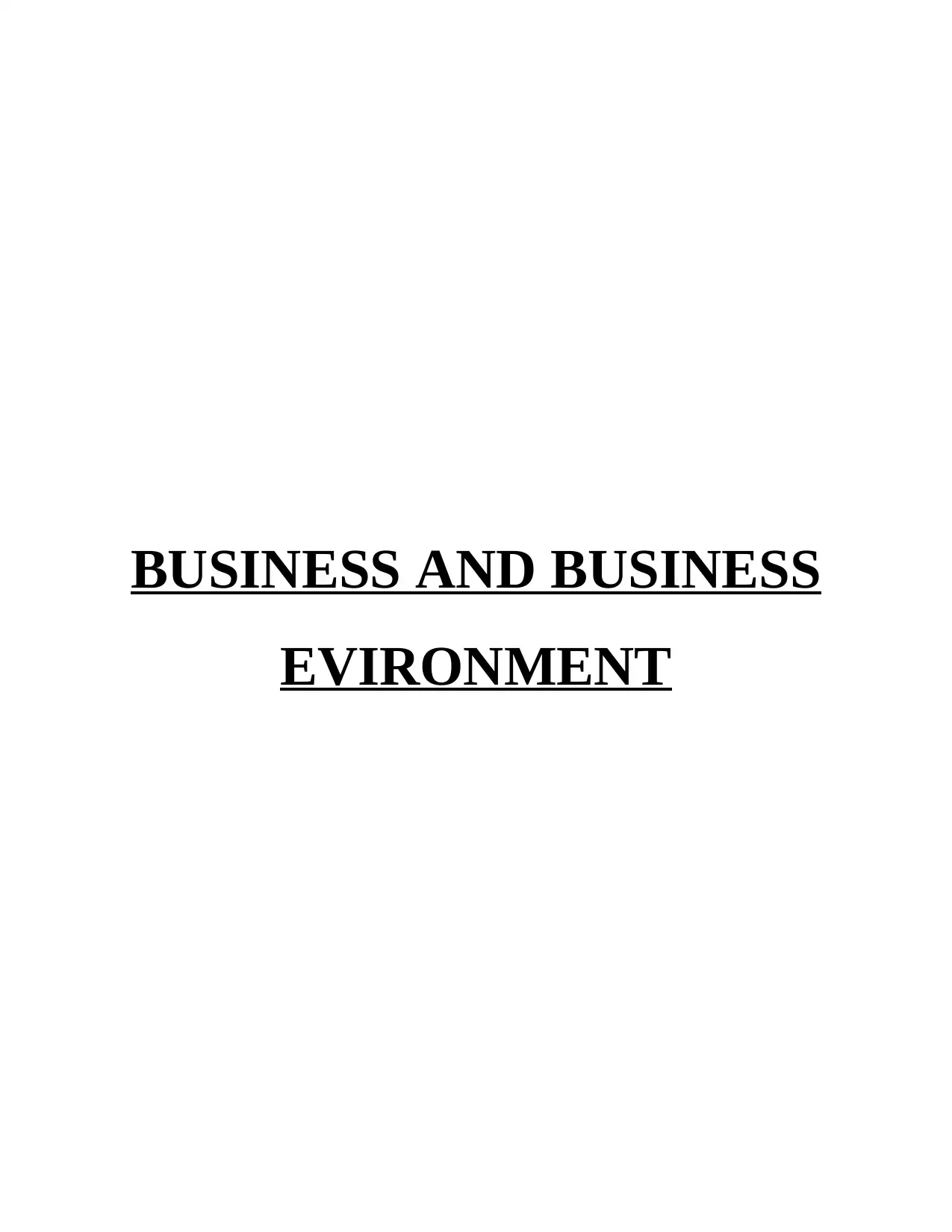
BUSINESS AND BUSINESS
EVIRONMENT
EVIRONMENT
Paraphrase This Document
Need a fresh take? Get an instant paraphrase of this document with our AI Paraphraser
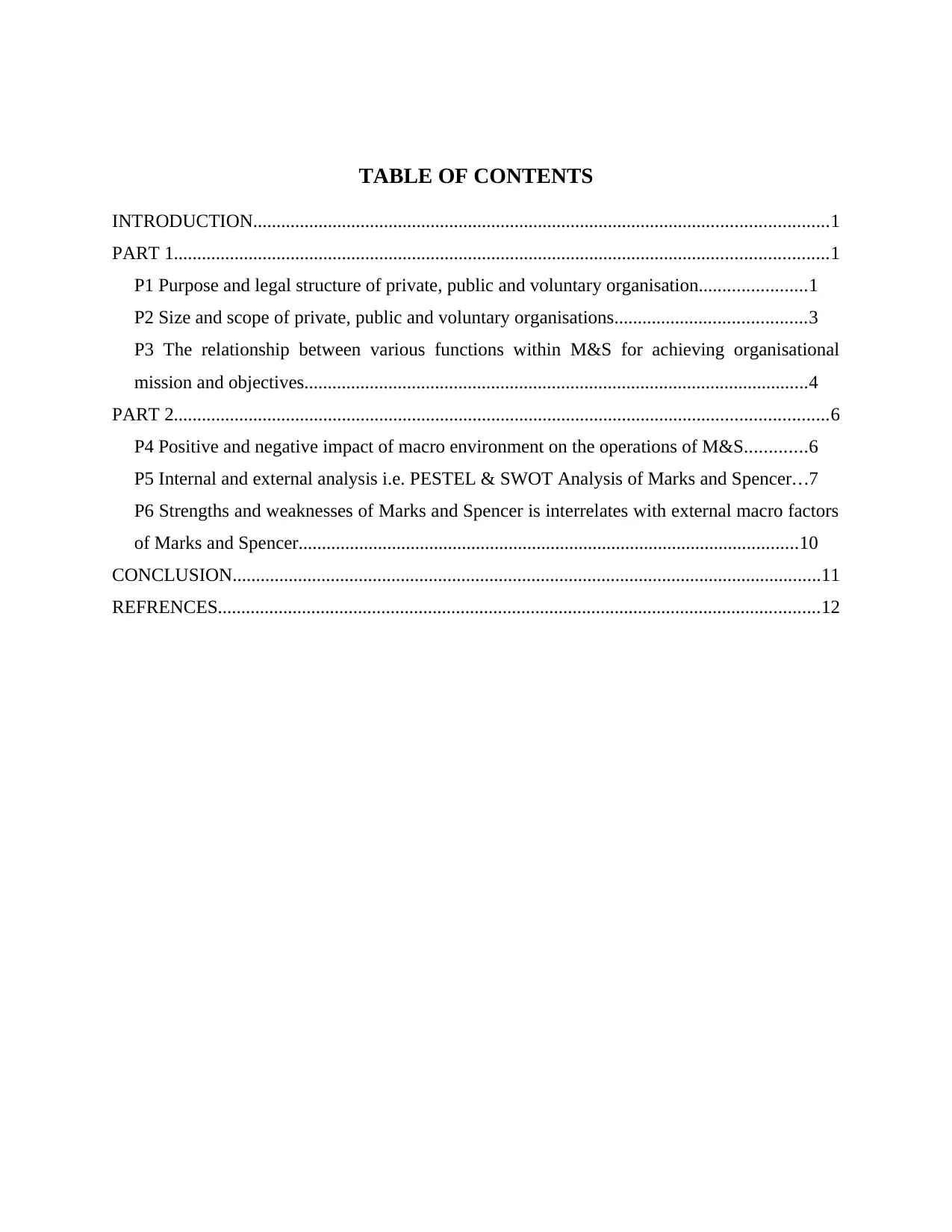
TABLE OF CONTENTS
INTRODUCTION...........................................................................................................................1
PART 1............................................................................................................................................1
P1 Purpose and legal structure of private, public and voluntary organisation.......................1
P2 Size and scope of private, public and voluntary organisations.........................................3
P3 The relationship between various functions within M&S for achieving organisational
mission and objectives............................................................................................................4
PART 2............................................................................................................................................6
P4 Positive and negative impact of macro environment on the operations of M&S.............6
P5 Internal and external analysis i.e. PESTEL & SWOT Analysis of Marks and Spencer...7
P6 Strengths and weaknesses of Marks and Spencer is interrelates with external macro factors
of Marks and Spencer...........................................................................................................10
CONCLUSION..............................................................................................................................11
REFRENCES.................................................................................................................................12
INTRODUCTION...........................................................................................................................1
PART 1............................................................................................................................................1
P1 Purpose and legal structure of private, public and voluntary organisation.......................1
P2 Size and scope of private, public and voluntary organisations.........................................3
P3 The relationship between various functions within M&S for achieving organisational
mission and objectives............................................................................................................4
PART 2............................................................................................................................................6
P4 Positive and negative impact of macro environment on the operations of M&S.............6
P5 Internal and external analysis i.e. PESTEL & SWOT Analysis of Marks and Spencer...7
P6 Strengths and weaknesses of Marks and Spencer is interrelates with external macro factors
of Marks and Spencer...........................................................................................................10
CONCLUSION..............................................................................................................................11
REFRENCES.................................................................................................................................12
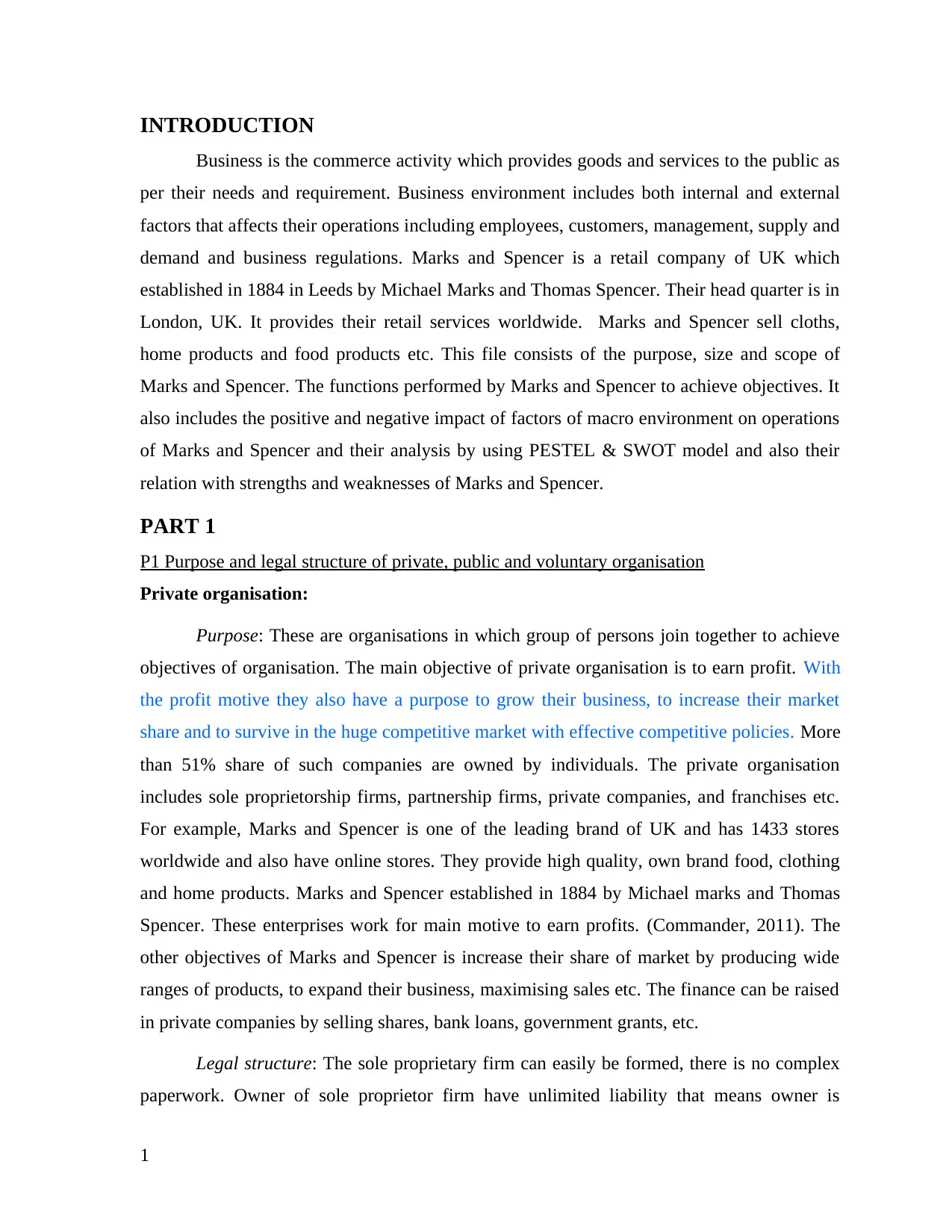
INTRODUCTION
Business is the commerce activity which provides goods and services to the public as
per their needs and requirement. Business environment includes both internal and external
factors that affects their operations including employees, customers, management, supply and
demand and business regulations. Marks and Spencer is a retail company of UK which
established in 1884 in Leeds by Michael Marks and Thomas Spencer. Their head quarter is in
London, UK. It provides their retail services worldwide. Marks and Spencer sell cloths,
home products and food products etc. This file consists of the purpose, size and scope of
Marks and Spencer. The functions performed by Marks and Spencer to achieve objectives. It
also includes the positive and negative impact of factors of macro environment on operations
of Marks and Spencer and their analysis by using PESTEL & SWOT model and also their
relation with strengths and weaknesses of Marks and Spencer.
PART 1
P1 Purpose and legal structure of private, public and voluntary organisation
Private organisation:
Purpose: These are organisations in which group of persons join together to achieve
objectives of organisation. The main objective of private organisation is to earn profit. With
the profit motive they also have a purpose to grow their business, to increase their market
share and to survive in the huge competitive market with effective competitive policies. More
than 51% share of such companies are owned by individuals. The private organisation
includes sole proprietorship firms, partnership firms, private companies, and franchises etc.
For example, Marks and Spencer is one of the leading brand of UK and has 1433 stores
worldwide and also have online stores. They provide high quality, own brand food, clothing
and home products. Marks and Spencer established in 1884 by Michael marks and Thomas
Spencer. These enterprises work for main motive to earn profits. (Commander, 2011). The
other objectives of Marks and Spencer is increase their share of market by producing wide
ranges of products, to expand their business, maximising sales etc. The finance can be raised
in private companies by selling shares, bank loans, government grants, etc.
Legal structure: The sole proprietary firm can easily be formed, there is no complex
paperwork. Owner of sole proprietor firm have unlimited liability that means owner is
1
Business is the commerce activity which provides goods and services to the public as
per their needs and requirement. Business environment includes both internal and external
factors that affects their operations including employees, customers, management, supply and
demand and business regulations. Marks and Spencer is a retail company of UK which
established in 1884 in Leeds by Michael Marks and Thomas Spencer. Their head quarter is in
London, UK. It provides their retail services worldwide. Marks and Spencer sell cloths,
home products and food products etc. This file consists of the purpose, size and scope of
Marks and Spencer. The functions performed by Marks and Spencer to achieve objectives. It
also includes the positive and negative impact of factors of macro environment on operations
of Marks and Spencer and their analysis by using PESTEL & SWOT model and also their
relation with strengths and weaknesses of Marks and Spencer.
PART 1
P1 Purpose and legal structure of private, public and voluntary organisation
Private organisation:
Purpose: These are organisations in which group of persons join together to achieve
objectives of organisation. The main objective of private organisation is to earn profit. With
the profit motive they also have a purpose to grow their business, to increase their market
share and to survive in the huge competitive market with effective competitive policies. More
than 51% share of such companies are owned by individuals. The private organisation
includes sole proprietorship firms, partnership firms, private companies, and franchises etc.
For example, Marks and Spencer is one of the leading brand of UK and has 1433 stores
worldwide and also have online stores. They provide high quality, own brand food, clothing
and home products. Marks and Spencer established in 1884 by Michael marks and Thomas
Spencer. These enterprises work for main motive to earn profits. (Commander, 2011). The
other objectives of Marks and Spencer is increase their share of market by producing wide
ranges of products, to expand their business, maximising sales etc. The finance can be raised
in private companies by selling shares, bank loans, government grants, etc.
Legal structure: The sole proprietary firm can easily be formed, there is no complex
paperwork. Owner of sole proprietor firm have unlimited liability that means owner is
1
⊘ This is a preview!⊘
Do you want full access?
Subscribe today to unlock all pages.

Trusted by 1+ million students worldwide
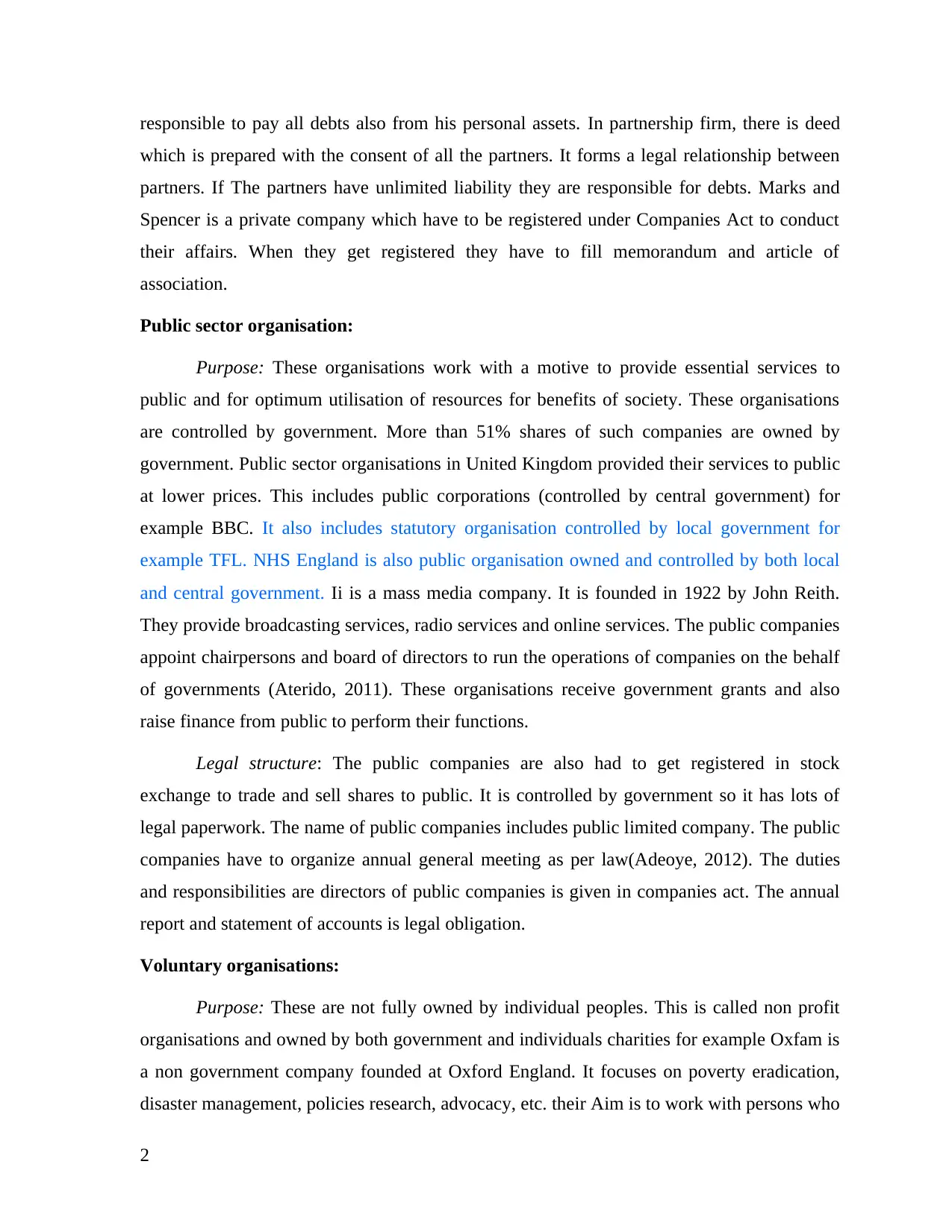
responsible to pay all debts also from his personal assets. In partnership firm, there is deed
which is prepared with the consent of all the partners. It forms a legal relationship between
partners. If The partners have unlimited liability they are responsible for debts. Marks and
Spencer is a private company which have to be registered under Companies Act to conduct
their affairs. When they get registered they have to fill memorandum and article of
association.
Public sector organisation:
Purpose: These organisations work with a motive to provide essential services to
public and for optimum utilisation of resources for benefits of society. These organisations
are controlled by government. More than 51% shares of such companies are owned by
government. Public sector organisations in United Kingdom provided their services to public
at lower prices. This includes public corporations (controlled by central government) for
example BBC. It also includes statutory organisation controlled by local government for
example TFL. NHS England is also public organisation owned and controlled by both local
and central government. Ii is a mass media company. It is founded in 1922 by John Reith.
They provide broadcasting services, radio services and online services. The public companies
appoint chairpersons and board of directors to run the operations of companies on the behalf
of governments (Aterido, 2011). These organisations receive government grants and also
raise finance from public to perform their functions.
Legal structure: The public companies are also had to get registered in stock
exchange to trade and sell shares to public. It is controlled by government so it has lots of
legal paperwork. The name of public companies includes public limited company. The public
companies have to organize annual general meeting as per law(Adeoye, 2012). The duties
and responsibilities are directors of public companies is given in companies act. The annual
report and statement of accounts is legal obligation.
Voluntary organisations:
Purpose: These are not fully owned by individual peoples. This is called non profit
organisations and owned by both government and individuals charities for example Oxfam is
a non government company founded at Oxford England. It focuses on poverty eradication,
disaster management, policies research, advocacy, etc. their Aim is to work with persons who
2
which is prepared with the consent of all the partners. It forms a legal relationship between
partners. If The partners have unlimited liability they are responsible for debts. Marks and
Spencer is a private company which have to be registered under Companies Act to conduct
their affairs. When they get registered they have to fill memorandum and article of
association.
Public sector organisation:
Purpose: These organisations work with a motive to provide essential services to
public and for optimum utilisation of resources for benefits of society. These organisations
are controlled by government. More than 51% shares of such companies are owned by
government. Public sector organisations in United Kingdom provided their services to public
at lower prices. This includes public corporations (controlled by central government) for
example BBC. It also includes statutory organisation controlled by local government for
example TFL. NHS England is also public organisation owned and controlled by both local
and central government. Ii is a mass media company. It is founded in 1922 by John Reith.
They provide broadcasting services, radio services and online services. The public companies
appoint chairpersons and board of directors to run the operations of companies on the behalf
of governments (Aterido, 2011). These organisations receive government grants and also
raise finance from public to perform their functions.
Legal structure: The public companies are also had to get registered in stock
exchange to trade and sell shares to public. It is controlled by government so it has lots of
legal paperwork. The name of public companies includes public limited company. The public
companies have to organize annual general meeting as per law(Adeoye, 2012). The duties
and responsibilities are directors of public companies is given in companies act. The annual
report and statement of accounts is legal obligation.
Voluntary organisations:
Purpose: These are not fully owned by individual peoples. This is called non profit
organisations and owned by both government and individuals charities for example Oxfam is
a non government company founded at Oxford England. It focuses on poverty eradication,
disaster management, policies research, advocacy, etc. their Aim is to work with persons who
2
Paraphrase This Document
Need a fresh take? Get an instant paraphrase of this document with our AI Paraphraser
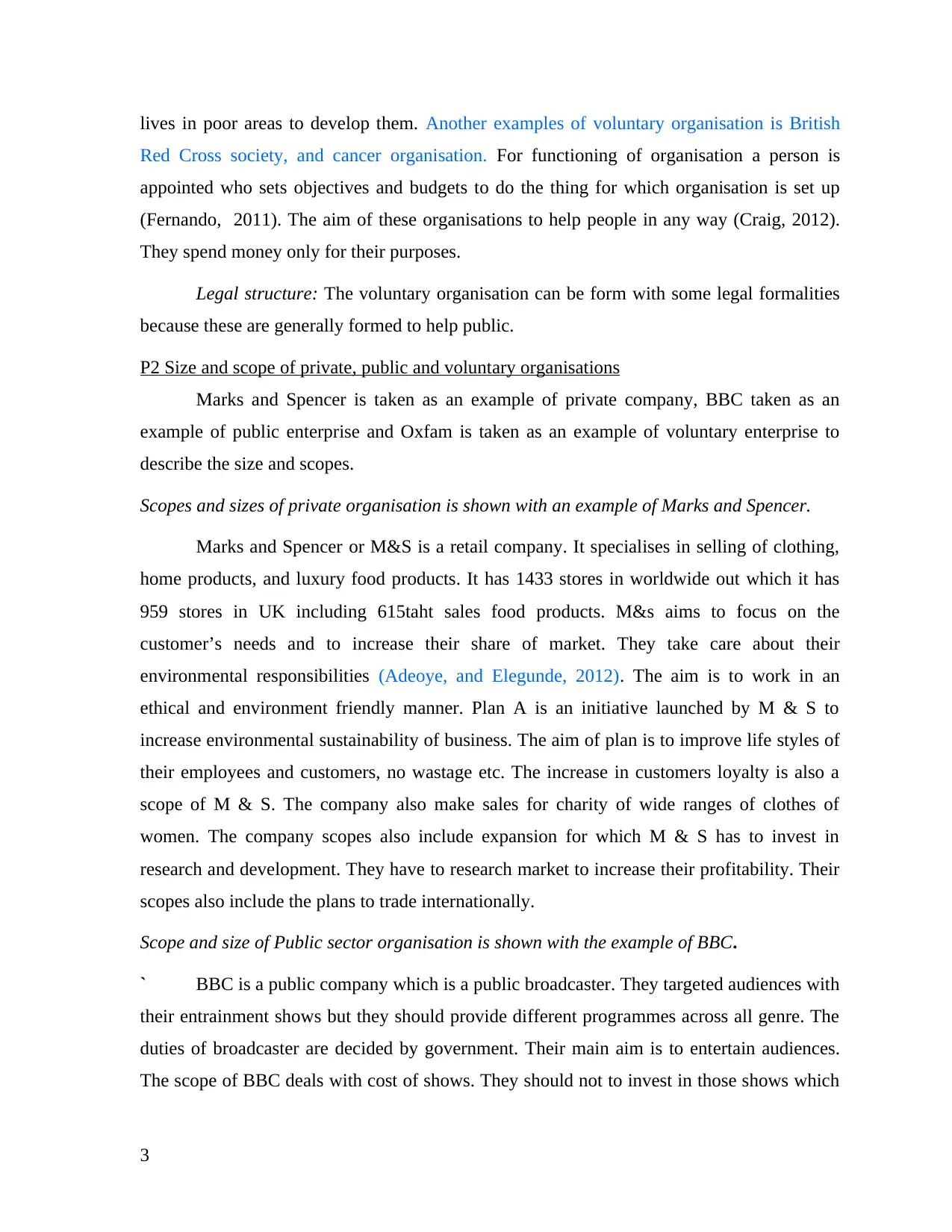
lives in poor areas to develop them. Another examples of voluntary organisation is British
Red Cross society, and cancer organisation. For functioning of organisation a person is
appointed who sets objectives and budgets to do the thing for which organisation is set up
(Fernando, 2011). The aim of these organisations to help people in any way (Craig, 2012).
They spend money only for their purposes.
Legal structure: The voluntary organisation can be form with some legal formalities
because these are generally formed to help public.
P2 Size and scope of private, public and voluntary organisations
Marks and Spencer is taken as an example of private company, BBC taken as an
example of public enterprise and Oxfam is taken as an example of voluntary enterprise to
describe the size and scopes.
Scopes and sizes of private organisation is shown with an example of Marks and Spencer.
Marks and Spencer or M&S is a retail company. It specialises in selling of clothing,
home products, and luxury food products. It has 1433 stores in worldwide out which it has
959 stores in UK including 615taht sales food products. M&s aims to focus on the
customer’s needs and to increase their share of market. They take care about their
environmental responsibilities (Adeoye, and Elegunde, 2012). The aim is to work in an
ethical and environment friendly manner. Plan A is an initiative launched by M & S to
increase environmental sustainability of business. The aim of plan is to improve life styles of
their employees and customers, no wastage etc. The increase in customers loyalty is also a
scope of M & S. The company also make sales for charity of wide ranges of clothes of
women. The company scopes also include expansion for which M & S has to invest in
research and development. They have to research market to increase their profitability. Their
scopes also include the plans to trade internationally.
Scope and size of Public sector organisation is shown with the example of BBC.
` BBC is a public company which is a public broadcaster. They targeted audiences with
their entrainment shows but they should provide different programmes across all genre. The
duties of broadcaster are decided by government. Their main aim is to entertain audiences.
The scope of BBC deals with cost of shows. They should not to invest in those shows which
3
Red Cross society, and cancer organisation. For functioning of organisation a person is
appointed who sets objectives and budgets to do the thing for which organisation is set up
(Fernando, 2011). The aim of these organisations to help people in any way (Craig, 2012).
They spend money only for their purposes.
Legal structure: The voluntary organisation can be form with some legal formalities
because these are generally formed to help public.
P2 Size and scope of private, public and voluntary organisations
Marks and Spencer is taken as an example of private company, BBC taken as an
example of public enterprise and Oxfam is taken as an example of voluntary enterprise to
describe the size and scopes.
Scopes and sizes of private organisation is shown with an example of Marks and Spencer.
Marks and Spencer or M&S is a retail company. It specialises in selling of clothing,
home products, and luxury food products. It has 1433 stores in worldwide out which it has
959 stores in UK including 615taht sales food products. M&s aims to focus on the
customer’s needs and to increase their share of market. They take care about their
environmental responsibilities (Adeoye, and Elegunde, 2012). The aim is to work in an
ethical and environment friendly manner. Plan A is an initiative launched by M & S to
increase environmental sustainability of business. The aim of plan is to improve life styles of
their employees and customers, no wastage etc. The increase in customers loyalty is also a
scope of M & S. The company also make sales for charity of wide ranges of clothes of
women. The company scopes also include expansion for which M & S has to invest in
research and development. They have to research market to increase their profitability. Their
scopes also include the plans to trade internationally.
Scope and size of Public sector organisation is shown with the example of BBC.
` BBC is a public company which is a public broadcaster. They targeted audiences with
their entrainment shows but they should provide different programmes across all genre. The
duties of broadcaster are decided by government. Their main aim is to entertain audiences.
The scope of BBC deals with cost of shows. They should not to invest in those shows which
3
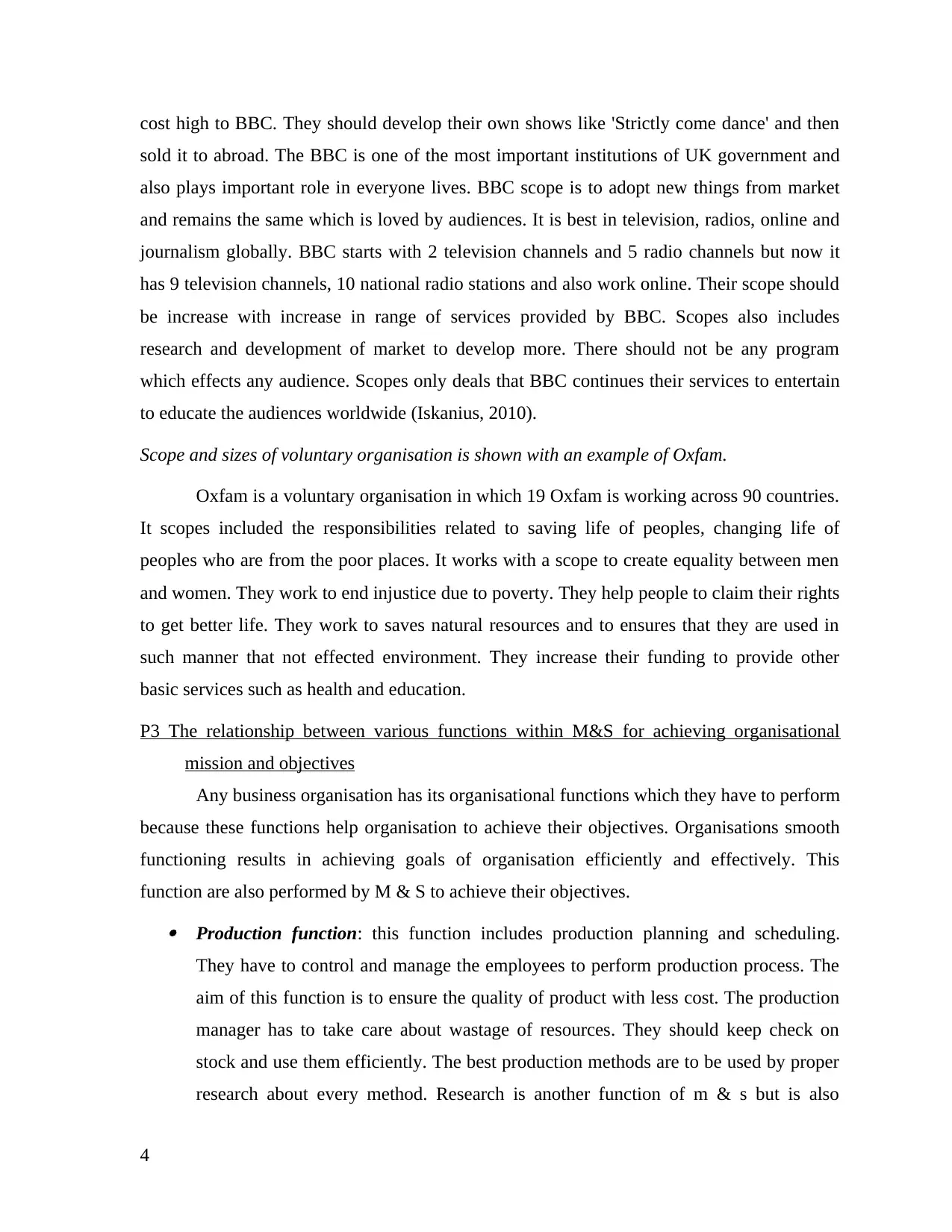
cost high to BBC. They should develop their own shows like 'Strictly come dance' and then
sold it to abroad. The BBC is one of the most important institutions of UK government and
also plays important role in everyone lives. BBC scope is to adopt new things from market
and remains the same which is loved by audiences. It is best in television, radios, online and
journalism globally. BBC starts with 2 television channels and 5 radio channels but now it
has 9 television channels, 10 national radio stations and also work online. Their scope should
be increase with increase in range of services provided by BBC. Scopes also includes
research and development of market to develop more. There should not be any program
which effects any audience. Scopes only deals that BBC continues their services to entertain
to educate the audiences worldwide (Iskanius, 2010).
Scope and sizes of voluntary organisation is shown with an example of Oxfam.
Oxfam is a voluntary organisation in which 19 Oxfam is working across 90 countries.
It scopes included the responsibilities related to saving life of peoples, changing life of
peoples who are from the poor places. It works with a scope to create equality between men
and women. They work to end injustice due to poverty. They help people to claim their rights
to get better life. They work to saves natural resources and to ensures that they are used in
such manner that not effected environment. They increase their funding to provide other
basic services such as health and education.
P3 The relationship between various functions within M&S for achieving organisational
mission and objectives
Any business organisation has its organisational functions which they have to perform
because these functions help organisation to achieve their objectives. Organisations smooth
functioning results in achieving goals of organisation efficiently and effectively. This
function are also performed by M & S to achieve their objectives. Production function: this function includes production planning and scheduling.
They have to control and manage the employees to perform production process. The
aim of this function is to ensure the quality of product with less cost. The production
manager has to take care about wastage of resources. They should keep check on
stock and use them efficiently. The best production methods are to be used by proper
research about every method. Research is another function of m & s but is also
4
sold it to abroad. The BBC is one of the most important institutions of UK government and
also plays important role in everyone lives. BBC scope is to adopt new things from market
and remains the same which is loved by audiences. It is best in television, radios, online and
journalism globally. BBC starts with 2 television channels and 5 radio channels but now it
has 9 television channels, 10 national radio stations and also work online. Their scope should
be increase with increase in range of services provided by BBC. Scopes also includes
research and development of market to develop more. There should not be any program
which effects any audience. Scopes only deals that BBC continues their services to entertain
to educate the audiences worldwide (Iskanius, 2010).
Scope and sizes of voluntary organisation is shown with an example of Oxfam.
Oxfam is a voluntary organisation in which 19 Oxfam is working across 90 countries.
It scopes included the responsibilities related to saving life of peoples, changing life of
peoples who are from the poor places. It works with a scope to create equality between men
and women. They work to end injustice due to poverty. They help people to claim their rights
to get better life. They work to saves natural resources and to ensures that they are used in
such manner that not effected environment. They increase their funding to provide other
basic services such as health and education.
P3 The relationship between various functions within M&S for achieving organisational
mission and objectives
Any business organisation has its organisational functions which they have to perform
because these functions help organisation to achieve their objectives. Organisations smooth
functioning results in achieving goals of organisation efficiently and effectively. This
function are also performed by M & S to achieve their objectives. Production function: this function includes production planning and scheduling.
They have to control and manage the employees to perform production process. The
aim of this function is to ensure the quality of product with less cost. The production
manager has to take care about wastage of resources. They should keep check on
stock and use them efficiently. The best production methods are to be used by proper
research about every method. Research is another function of m & s but is also
4
⊘ This is a preview!⊘
Do you want full access?
Subscribe today to unlock all pages.

Trusted by 1+ million students worldwide
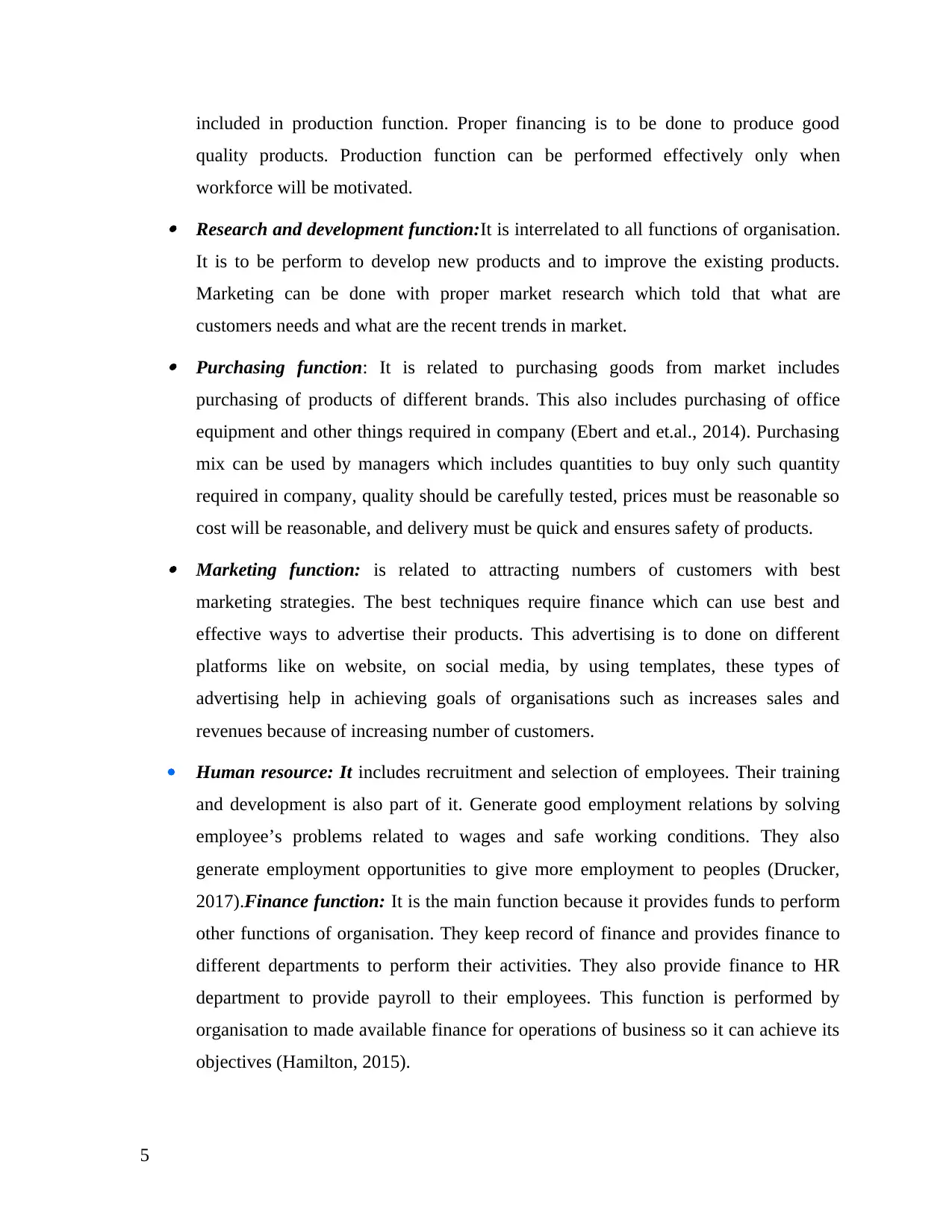
included in production function. Proper financing is to be done to produce good
quality products. Production function can be performed effectively only when
workforce will be motivated. Research and development function:It is interrelated to all functions of organisation.
It is to be perform to develop new products and to improve the existing products.
Marketing can be done with proper market research which told that what are
customers needs and what are the recent trends in market. Purchasing function: It is related to purchasing goods from market includes
purchasing of products of different brands. This also includes purchasing of office
equipment and other things required in company (Ebert and et.al., 2014). Purchasing
mix can be used by managers which includes quantities to buy only such quantity
required in company, quality should be carefully tested, prices must be reasonable so
cost will be reasonable, and delivery must be quick and ensures safety of products. Marketing function: is related to attracting numbers of customers with best
marketing strategies. The best techniques require finance which can use best and
effective ways to advertise their products. This advertising is to done on different
platforms like on website, on social media, by using templates, these types of
advertising help in achieving goals of organisations such as increases sales and
revenues because of increasing number of customers.
Human resource: It includes recruitment and selection of employees. Their training
and development is also part of it. Generate good employment relations by solving
employee’s problems related to wages and safe working conditions. They also
generate employment opportunities to give more employment to peoples (Drucker,
2017).Finance function: It is the main function because it provides funds to perform
other functions of organisation. They keep record of finance and provides finance to
different departments to perform their activities. They also provide finance to HR
department to provide payroll to their employees. This function is performed by
organisation to made available finance for operations of business so it can achieve its
objectives (Hamilton, 2015).
5
quality products. Production function can be performed effectively only when
workforce will be motivated. Research and development function:It is interrelated to all functions of organisation.
It is to be perform to develop new products and to improve the existing products.
Marketing can be done with proper market research which told that what are
customers needs and what are the recent trends in market. Purchasing function: It is related to purchasing goods from market includes
purchasing of products of different brands. This also includes purchasing of office
equipment and other things required in company (Ebert and et.al., 2014). Purchasing
mix can be used by managers which includes quantities to buy only such quantity
required in company, quality should be carefully tested, prices must be reasonable so
cost will be reasonable, and delivery must be quick and ensures safety of products. Marketing function: is related to attracting numbers of customers with best
marketing strategies. The best techniques require finance which can use best and
effective ways to advertise their products. This advertising is to done on different
platforms like on website, on social media, by using templates, these types of
advertising help in achieving goals of organisations such as increases sales and
revenues because of increasing number of customers.
Human resource: It includes recruitment and selection of employees. Their training
and development is also part of it. Generate good employment relations by solving
employee’s problems related to wages and safe working conditions. They also
generate employment opportunities to give more employment to peoples (Drucker,
2017).Finance function: It is the main function because it provides funds to perform
other functions of organisation. They keep record of finance and provides finance to
different departments to perform their activities. They also provide finance to HR
department to provide payroll to their employees. This function is performed by
organisation to made available finance for operations of business so it can achieve its
objectives (Hamilton, 2015).
5
Paraphrase This Document
Need a fresh take? Get an instant paraphrase of this document with our AI Paraphraser
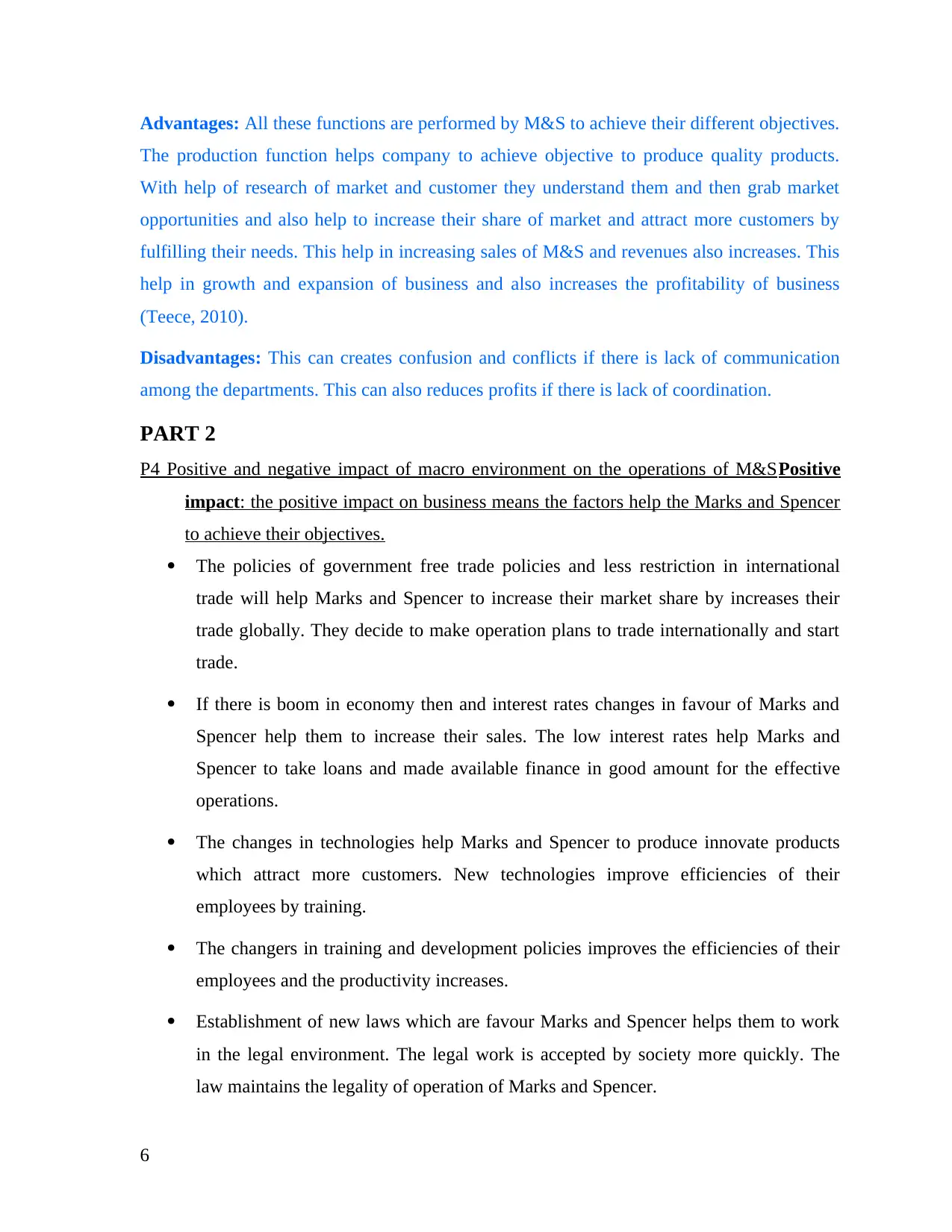
Advantages: All these functions are performed by M&S to achieve their different objectives.
The production function helps company to achieve objective to produce quality products.
With help of research of market and customer they understand them and then grab market
opportunities and also help to increase their share of market and attract more customers by
fulfilling their needs. This help in increasing sales of M&S and revenues also increases. This
help in growth and expansion of business and also increases the profitability of business
(Teece, 2010).
Disadvantages: This can creates confusion and conflicts if there is lack of communication
among the departments. This can also reduces profits if there is lack of coordination.
PART 2
P4 Positive and negative impact of macro environment on the operations of M&SPositive
impact: the positive impact on business means the factors help the Marks and Spencer
to achieve their objectives.
The policies of government free trade policies and less restriction in international
trade will help Marks and Spencer to increase their market share by increases their
trade globally. They decide to make operation plans to trade internationally and start
trade.
If there is boom in economy then and interest rates changes in favour of Marks and
Spencer help them to increase their sales. The low interest rates help Marks and
Spencer to take loans and made available finance in good amount for the effective
operations.
The changes in technologies help Marks and Spencer to produce innovate products
which attract more customers. New technologies improve efficiencies of their
employees by training.
The changers in training and development policies improves the efficiencies of their
employees and the productivity increases.
Establishment of new laws which are favour Marks and Spencer helps them to work
in the legal environment. The legal work is accepted by society more quickly. The
law maintains the legality of operation of Marks and Spencer.
6
The production function helps company to achieve objective to produce quality products.
With help of research of market and customer they understand them and then grab market
opportunities and also help to increase their share of market and attract more customers by
fulfilling their needs. This help in increasing sales of M&S and revenues also increases. This
help in growth and expansion of business and also increases the profitability of business
(Teece, 2010).
Disadvantages: This can creates confusion and conflicts if there is lack of communication
among the departments. This can also reduces profits if there is lack of coordination.
PART 2
P4 Positive and negative impact of macro environment on the operations of M&SPositive
impact: the positive impact on business means the factors help the Marks and Spencer
to achieve their objectives.
The policies of government free trade policies and less restriction in international
trade will help Marks and Spencer to increase their market share by increases their
trade globally. They decide to make operation plans to trade internationally and start
trade.
If there is boom in economy then and interest rates changes in favour of Marks and
Spencer help them to increase their sales. The low interest rates help Marks and
Spencer to take loans and made available finance in good amount for the effective
operations.
The changes in technologies help Marks and Spencer to produce innovate products
which attract more customers. New technologies improve efficiencies of their
employees by training.
The changers in training and development policies improves the efficiencies of their
employees and the productivity increases.
Establishment of new laws which are favour Marks and Spencer helps them to work
in the legal environment. The legal work is accepted by society more quickly. The
law maintains the legality of operation of Marks and Spencer.
6
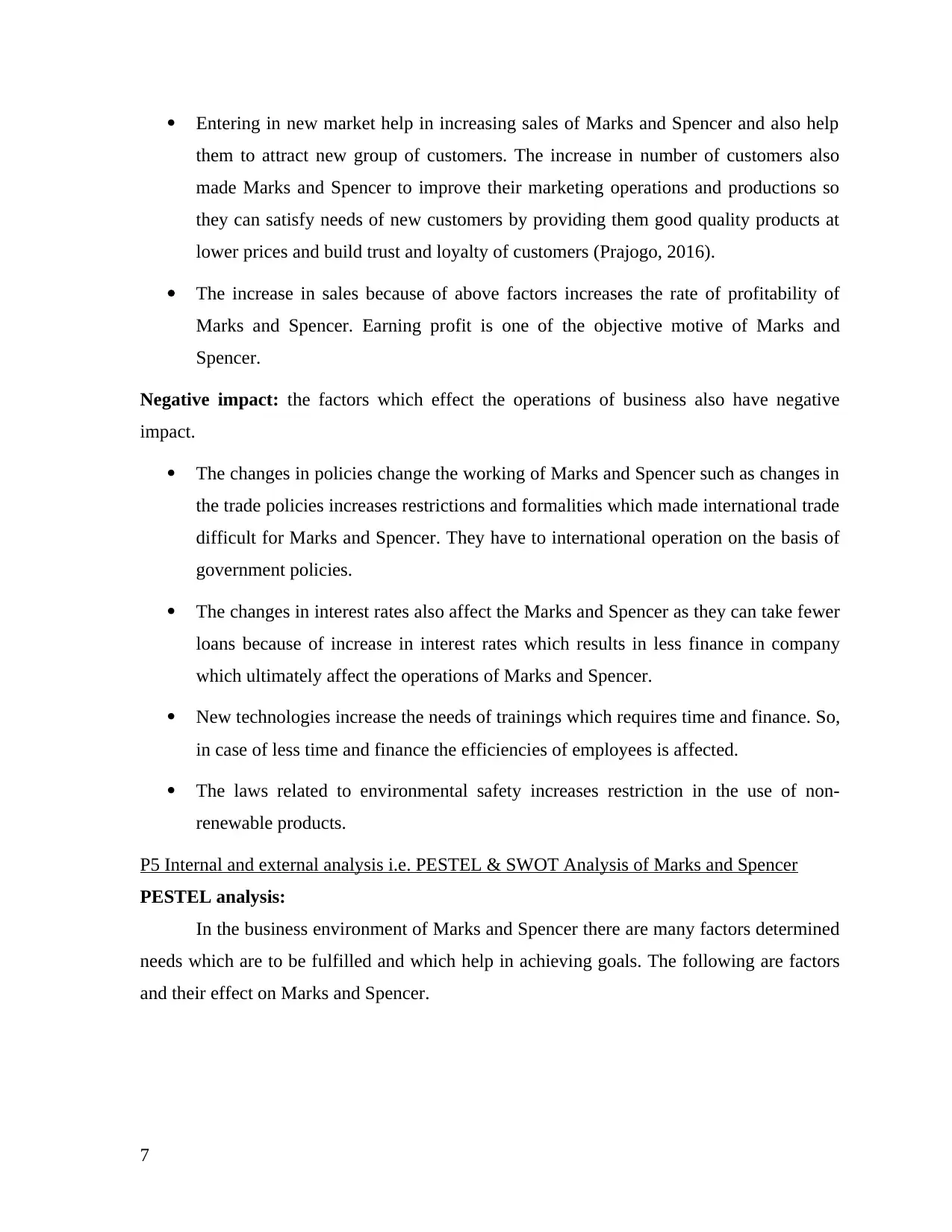
Entering in new market help in increasing sales of Marks and Spencer and also help
them to attract new group of customers. The increase in number of customers also
made Marks and Spencer to improve their marketing operations and productions so
they can satisfy needs of new customers by providing them good quality products at
lower prices and build trust and loyalty of customers (Prajogo, 2016).
The increase in sales because of above factors increases the rate of profitability of
Marks and Spencer. Earning profit is one of the objective motive of Marks and
Spencer.
Negative impact: the factors which effect the operations of business also have negative
impact.
The changes in policies change the working of Marks and Spencer such as changes in
the trade policies increases restrictions and formalities which made international trade
difficult for Marks and Spencer. They have to international operation on the basis of
government policies.
The changes in interest rates also affect the Marks and Spencer as they can take fewer
loans because of increase in interest rates which results in less finance in company
which ultimately affect the operations of Marks and Spencer.
New technologies increase the needs of trainings which requires time and finance. So,
in case of less time and finance the efficiencies of employees is affected.
The laws related to environmental safety increases restriction in the use of non-
renewable products.
P5 Internal and external analysis i.e. PESTEL & SWOT Analysis of Marks and Spencer
PESTEL analysis:
In the business environment of Marks and Spencer there are many factors determined
needs which are to be fulfilled and which help in achieving goals. The following are factors
and their effect on Marks and Spencer.
7
them to attract new group of customers. The increase in number of customers also
made Marks and Spencer to improve their marketing operations and productions so
they can satisfy needs of new customers by providing them good quality products at
lower prices and build trust and loyalty of customers (Prajogo, 2016).
The increase in sales because of above factors increases the rate of profitability of
Marks and Spencer. Earning profit is one of the objective motive of Marks and
Spencer.
Negative impact: the factors which effect the operations of business also have negative
impact.
The changes in policies change the working of Marks and Spencer such as changes in
the trade policies increases restrictions and formalities which made international trade
difficult for Marks and Spencer. They have to international operation on the basis of
government policies.
The changes in interest rates also affect the Marks and Spencer as they can take fewer
loans because of increase in interest rates which results in less finance in company
which ultimately affect the operations of Marks and Spencer.
New technologies increase the needs of trainings which requires time and finance. So,
in case of less time and finance the efficiencies of employees is affected.
The laws related to environmental safety increases restriction in the use of non-
renewable products.
P5 Internal and external analysis i.e. PESTEL & SWOT Analysis of Marks and Spencer
PESTEL analysis:
In the business environment of Marks and Spencer there are many factors determined
needs which are to be fulfilled and which help in achieving goals. The following are factors
and their effect on Marks and Spencer.
7
⊘ This is a preview!⊘
Do you want full access?
Subscribe today to unlock all pages.

Trusted by 1+ million students worldwide
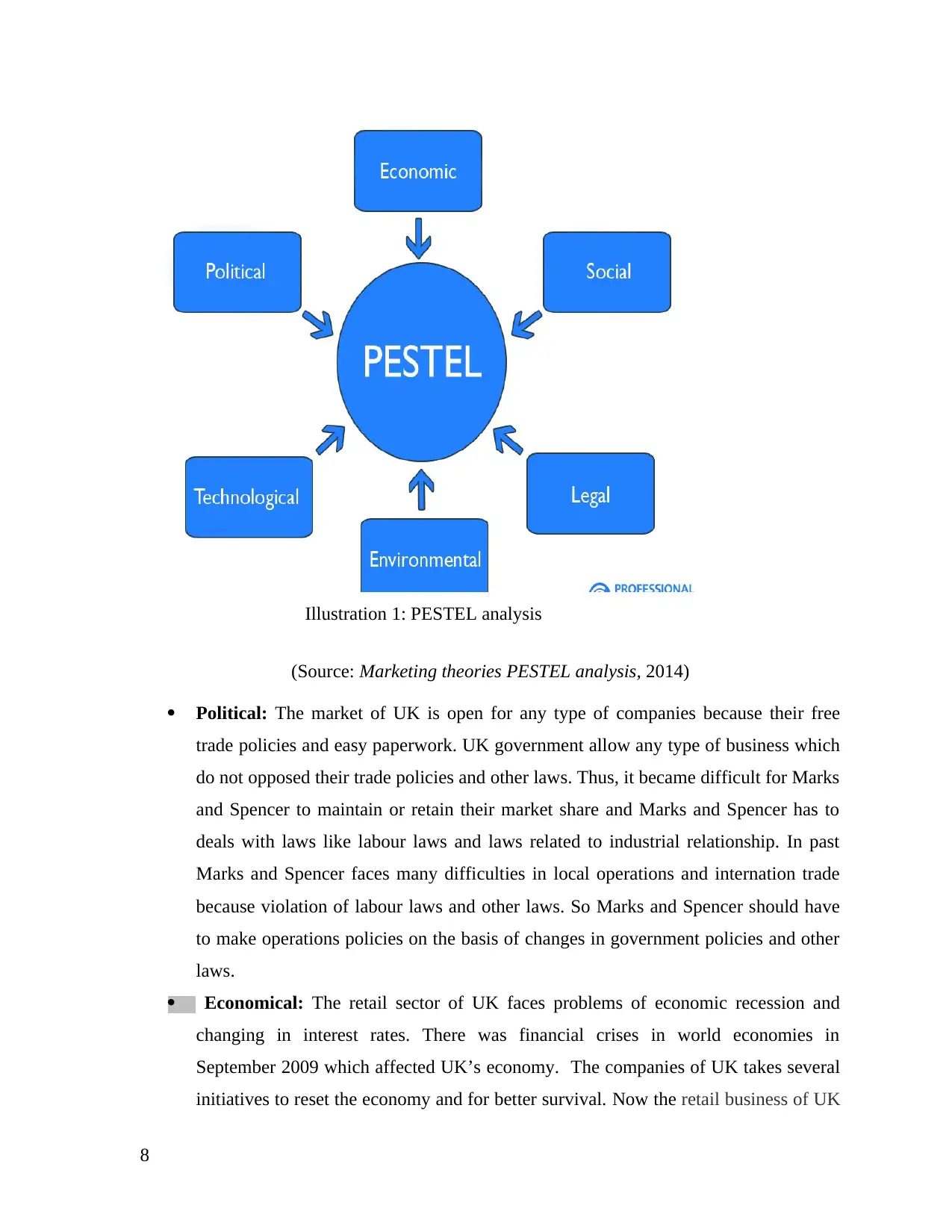
Illustration 1: PESTEL analysis
(Source: Marketing theories PESTEL analysis, 2014)
Political: The market of UK is open for any type of companies because their free
trade policies and easy paperwork. UK government allow any type of business which
do not opposed their trade policies and other laws. Thus, it became difficult for Marks
and Spencer to maintain or retain their market share and Marks and Spencer has to
deals with laws like labour laws and laws related to industrial relationship. In past
Marks and Spencer faces many difficulties in local operations and internation trade
because violation of labour laws and other laws. So Marks and Spencer should have
to make operations policies on the basis of changes in government policies and other
laws.
Economical: The retail sector of UK faces problems of economic recession and
changing in interest rates. There was financial crises in world economies in
September 2009 which affected UK’s economy. The companies of UK takes several
initiatives to reset the economy and for better survival. Now the retail business of UK
8
(Source: Marketing theories PESTEL analysis, 2014)
Political: The market of UK is open for any type of companies because their free
trade policies and easy paperwork. UK government allow any type of business which
do not opposed their trade policies and other laws. Thus, it became difficult for Marks
and Spencer to maintain or retain their market share and Marks and Spencer has to
deals with laws like labour laws and laws related to industrial relationship. In past
Marks and Spencer faces many difficulties in local operations and internation trade
because violation of labour laws and other laws. So Marks and Spencer should have
to make operations policies on the basis of changes in government policies and other
laws.
Economical: The retail sector of UK faces problems of economic recession and
changing in interest rates. There was financial crises in world economies in
September 2009 which affected UK’s economy. The companies of UK takes several
initiatives to reset the economy and for better survival. Now the retail business of UK
8
Paraphrase This Document
Need a fresh take? Get an instant paraphrase of this document with our AI Paraphraser
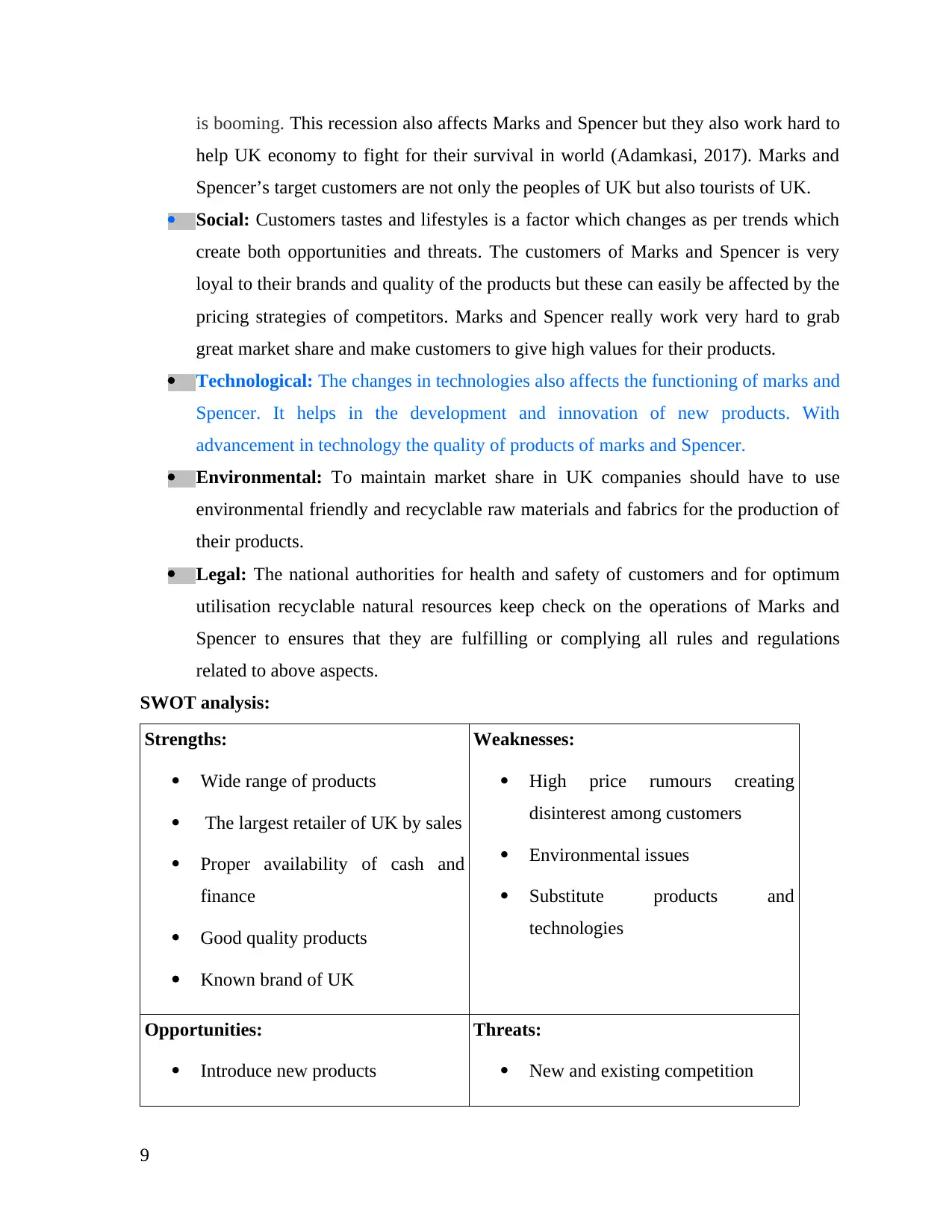
is booming. This recession also affects Marks and Spencer but they also work hard to
help UK economy to fight for their survival in world (Adamkasi, 2017). Marks and
Spencer’s target customers are not only the peoples of UK but also tourists of UK.
Social: Customers tastes and lifestyles is a factor which changes as per trends which
create both opportunities and threats. The customers of Marks and Spencer is very
loyal to their brands and quality of the products but these can easily be affected by the
pricing strategies of competitors. Marks and Spencer really work very hard to grab
great market share and make customers to give high values for their products.
Technological: The changes in technologies also affects the functioning of marks and
Spencer. It helps in the development and innovation of new products. With
advancement in technology the quality of products of marks and Spencer.
Environmental: To maintain market share in UK companies should have to use
environmental friendly and recyclable raw materials and fabrics for the production of
their products.
Legal: The national authorities for health and safety of customers and for optimum
utilisation recyclable natural resources keep check on the operations of Marks and
Spencer to ensures that they are fulfilling or complying all rules and regulations
related to above aspects.
SWOT analysis:
Strengths:
Wide range of products
The largest retailer of UK by sales
Proper availability of cash and
finance
Good quality products
Known brand of UK
Weaknesses:
High price rumours creating
disinterest among customers
Environmental issues
Substitute products and
technologies
Opportunities:
Introduce new products
Threats:
New and existing competition
9
help UK economy to fight for their survival in world (Adamkasi, 2017). Marks and
Spencer’s target customers are not only the peoples of UK but also tourists of UK.
Social: Customers tastes and lifestyles is a factor which changes as per trends which
create both opportunities and threats. The customers of Marks and Spencer is very
loyal to their brands and quality of the products but these can easily be affected by the
pricing strategies of competitors. Marks and Spencer really work very hard to grab
great market share and make customers to give high values for their products.
Technological: The changes in technologies also affects the functioning of marks and
Spencer. It helps in the development and innovation of new products. With
advancement in technology the quality of products of marks and Spencer.
Environmental: To maintain market share in UK companies should have to use
environmental friendly and recyclable raw materials and fabrics for the production of
their products.
Legal: The national authorities for health and safety of customers and for optimum
utilisation recyclable natural resources keep check on the operations of Marks and
Spencer to ensures that they are fulfilling or complying all rules and regulations
related to above aspects.
SWOT analysis:
Strengths:
Wide range of products
The largest retailer of UK by sales
Proper availability of cash and
finance
Good quality products
Known brand of UK
Weaknesses:
High price rumours creating
disinterest among customers
Environmental issues
Substitute products and
technologies
Opportunities:
Introduce new products
Threats:
New and existing competition
9
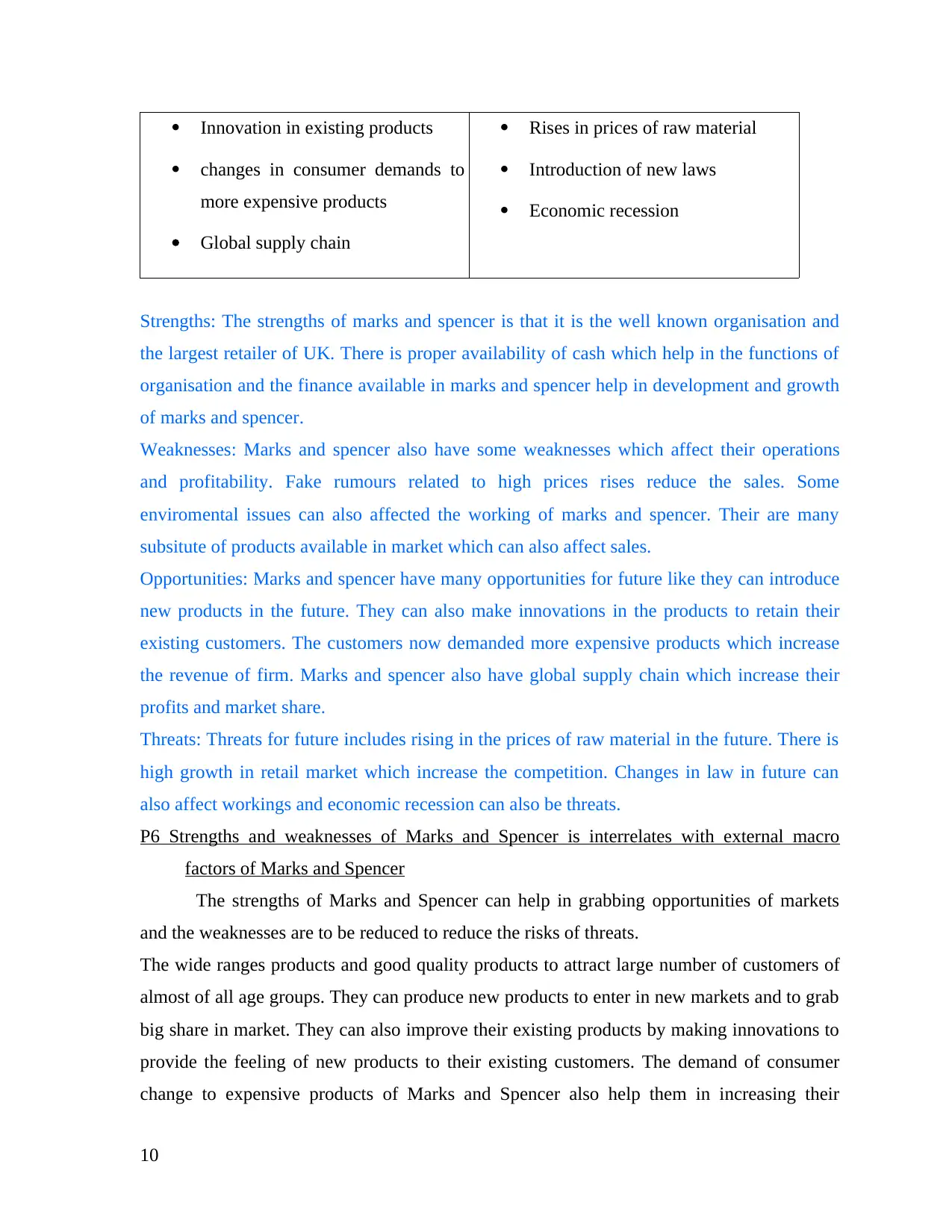
Innovation in existing products
changes in consumer demands to
more expensive products
Global supply chain
Rises in prices of raw material
Introduction of new laws
Economic recession
Strengths: The strengths of marks and spencer is that it is the well known organisation and
the largest retailer of UK. There is proper availability of cash which help in the functions of
organisation and the finance available in marks and spencer help in development and growth
of marks and spencer.
Weaknesses: Marks and spencer also have some weaknesses which affect their operations
and profitability. Fake rumours related to high prices rises reduce the sales. Some
enviromental issues can also affected the working of marks and spencer. Their are many
subsitute of products available in market which can also affect sales.
Opportunities: Marks and spencer have many opportunities for future like they can introduce
new products in the future. They can also make innovations in the products to retain their
existing customers. The customers now demanded more expensive products which increase
the revenue of firm. Marks and spencer also have global supply chain which increase their
profits and market share.
Threats: Threats for future includes rising in the prices of raw material in the future. There is
high growth in retail market which increase the competition. Changes in law in future can
also affect workings and economic recession can also be threats.
P6 Strengths and weaknesses of Marks and Spencer is interrelates with external macro
factors of Marks and Spencer
The strengths of Marks and Spencer can help in grabbing opportunities of markets
and the weaknesses are to be reduced to reduce the risks of threats.
The wide ranges products and good quality products to attract large number of customers of
almost of all age groups. They can produce new products to enter in new markets and to grab
big share in market. They can also improve their existing products by making innovations to
provide the feeling of new products to their existing customers. The demand of consumer
change to expensive products of Marks and Spencer also help them in increasing their
10
changes in consumer demands to
more expensive products
Global supply chain
Rises in prices of raw material
Introduction of new laws
Economic recession
Strengths: The strengths of marks and spencer is that it is the well known organisation and
the largest retailer of UK. There is proper availability of cash which help in the functions of
organisation and the finance available in marks and spencer help in development and growth
of marks and spencer.
Weaknesses: Marks and spencer also have some weaknesses which affect their operations
and profitability. Fake rumours related to high prices rises reduce the sales. Some
enviromental issues can also affected the working of marks and spencer. Their are many
subsitute of products available in market which can also affect sales.
Opportunities: Marks and spencer have many opportunities for future like they can introduce
new products in the future. They can also make innovations in the products to retain their
existing customers. The customers now demanded more expensive products which increase
the revenue of firm. Marks and spencer also have global supply chain which increase their
profits and market share.
Threats: Threats for future includes rising in the prices of raw material in the future. There is
high growth in retail market which increase the competition. Changes in law in future can
also affect workings and economic recession can also be threats.
P6 Strengths and weaknesses of Marks and Spencer is interrelates with external macro
factors of Marks and Spencer
The strengths of Marks and Spencer can help in grabbing opportunities of markets
and the weaknesses are to be reduced to reduce the risks of threats.
The wide ranges products and good quality products to attract large number of customers of
almost of all age groups. They can produce new products to enter in new markets and to grab
big share in market. They can also improve their existing products by making innovations to
provide the feeling of new products to their existing customers. The demand of consumer
change to expensive products of Marks and Spencer also help them in increasing their
10
⊘ This is a preview!⊘
Do you want full access?
Subscribe today to unlock all pages.

Trusted by 1+ million students worldwide
1 out of 16
Related Documents
Your All-in-One AI-Powered Toolkit for Academic Success.
+13062052269
info@desklib.com
Available 24*7 on WhatsApp / Email
![[object Object]](/_next/static/media/star-bottom.7253800d.svg)
Unlock your academic potential
Copyright © 2020–2025 A2Z Services. All Rights Reserved. Developed and managed by ZUCOL.





